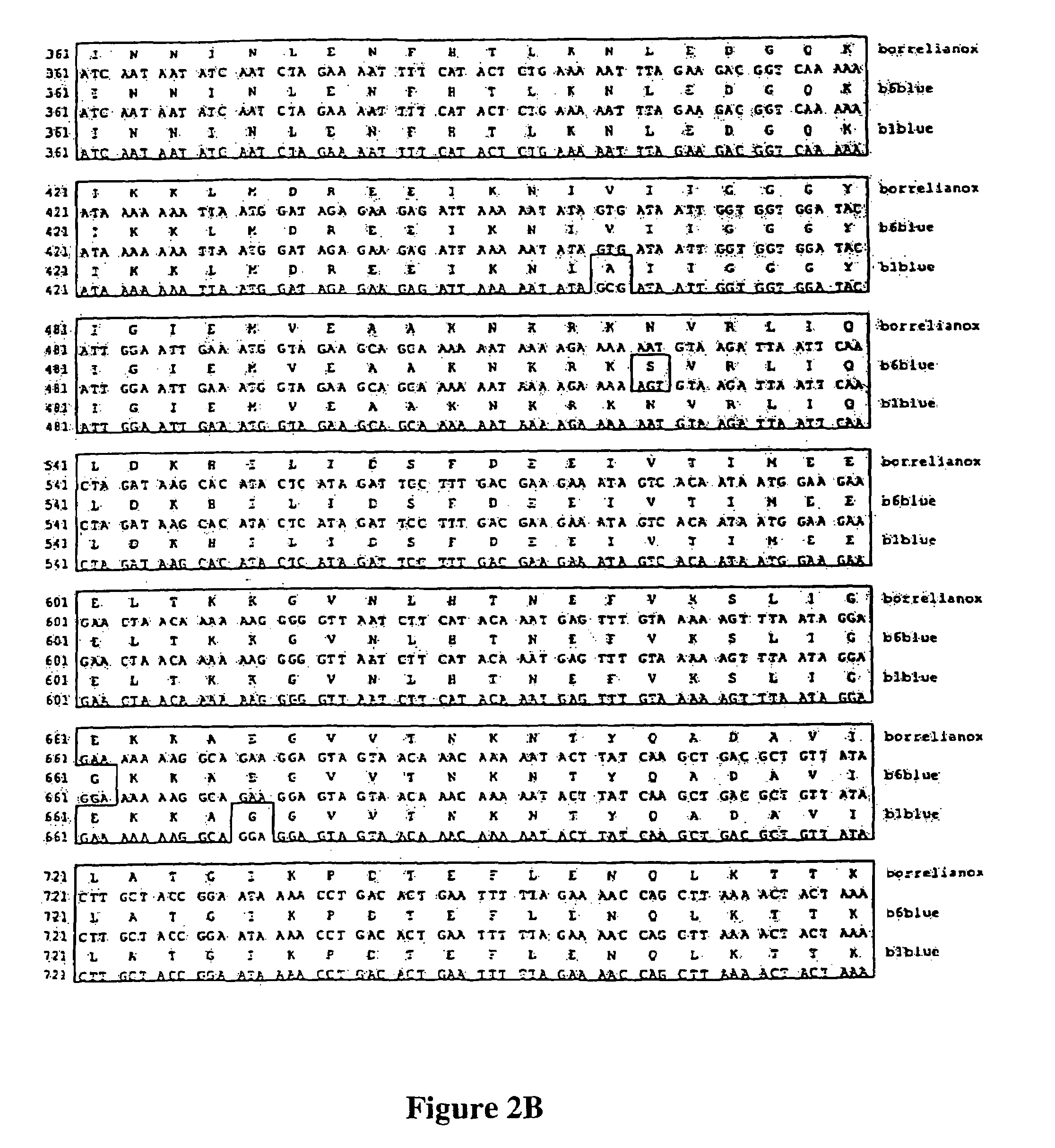Methods and compositions for NAD(P)(H) oxidases
a technology of nad(p)(h) oxidase and composition, which is applied in the field of bacteria nad (p) h oxidase, can solve the problems of concomitant reduction of molecular oxygen to water
- Summary
- Abstract
- Description
- Claims
- Application Information
AI Technical Summary
Benefits of technology
Problems solved by technology
Method used
Image
Examples
example 1
Bacterial Strains, Media and Growth Conditions
[0073]The genomic DNA from Borrelia burgdorferi (ATCC 35210) and the strain Lactobacillus sanfranciscensis (ATCC 27651) were obtained from ATCC and grown in MRS medium (Gibco) at pH 6.5 under facultatively anaerobic conditions at 30° C. in quiescent culture. For expression of wild-type NADH oxidase, the L. sanfranciscensis strain was grown in the same medium, but under aeration with 120 rpm in an Infors shaker at 30° C.
[0074]Host strains of E. coli were grown in Luria-Bertani medium at pH 7.5 and 37° C., for cloning purposes or routine growth and plasmid production the host strain XL1 blue (Stratagene, La Jolla) was used. For expression purposes an HB101 strain (Stratagene, La Jolla) or M15 strain including the pREP4 plasmid (Qiagen, Hilden) was employed. These E. coli strains were grown at 30° C. under agitation for optimized expression levels. Ampicillin was added to the medium at a final concentration of 100 μg / ml to maintain selectio...
example 2
Manipulation and Amplification of DNA
[0076]The nox DNA sequences were identified using a search of the NCBI Genebank (Accession files AB035801 for SFNOX and NC—001318 for BNOX). The corresponding specific 5′ and 3′ primers were synthesized at MWG Biotech (High Point, N.C.). Primer optimization was performed using a primer design program (webbased design, http: / genome-www2.stanford.edu / cgi-bin / SGD / web-primer). The nox genes from L. sanfranciscensis and B. burgdorferi were amplified using PCR and the gene-specific primers. Restriction sites used are underlined.
Primer Sequences:
[0077]
N- and C-terminal primers for L. sanfranciscensis5′ gcg c gaattc atg aaasanfransecoTm 67.2° C.gtt att gta gta ggt tgtact 3′5′ gcg c aagctt tta tttsanfranashindTm 62.8° C.atg tgc ttt gtc agc ttgtgc 3′N- and C-terminal primers for B. burgdorferi5′ gcg c gg atc c at gatborrnoxsTm 69.5° C.gaa aat aat aat tat tggggg 3′5′ gcg c aa gct t ct attborrnoxasTm 70.6° C.tgg cag cat tgc cag caatat t 3′
[0078]Amplification...
example 3
[0083]Nox-specific DNA from L. sanfranciscensis was ligated into pBluescript (Stratagene, La Jolla) using EcoR1 (5′) and HindIII (3′) restriction sites and accordingly, nox from B. burgdorferi with BamH1(5′) and HindIII (3′) restriction sites. For all necessary ligations the Rapid Ligation kit protocol (Roche, Penzberg) was followed. The same pmol amounts of DNA were ligated, concentrations were calculated accordingly using the spectrophotometrically determined 260 / 280 nm ratio. Wildtype or mutant expression clones were constructed with the same restriction sites of Nox-L-sanfranciscensis (Lsfnox) into pkk223-3 (Amersham, Piscataway, N.J.) and nox-B-burgdorferi (Bnox) into pBtac2 (Roche, Penzberg). Positive clones were tested either through colony PCR or restriction digest after plasmid preparation using the Miniprep Spin kit (Qiagen, Hilden).
PUM
| Property | Measurement | Unit |
|---|---|---|
| pH | aaaaa | aaaaa |
| temperatures | aaaaa | aaaaa |
| pH | aaaaa | aaaaa |
Abstract
Description
Claims
Application Information
 Login to View More
Login to View More - R&D
- Intellectual Property
- Life Sciences
- Materials
- Tech Scout
- Unparalleled Data Quality
- Higher Quality Content
- 60% Fewer Hallucinations
Browse by: Latest US Patents, China's latest patents, Technical Efficacy Thesaurus, Application Domain, Technology Topic, Popular Technical Reports.
© 2025 PatSnap. All rights reserved.Legal|Privacy policy|Modern Slavery Act Transparency Statement|Sitemap|About US| Contact US: help@patsnap.com



